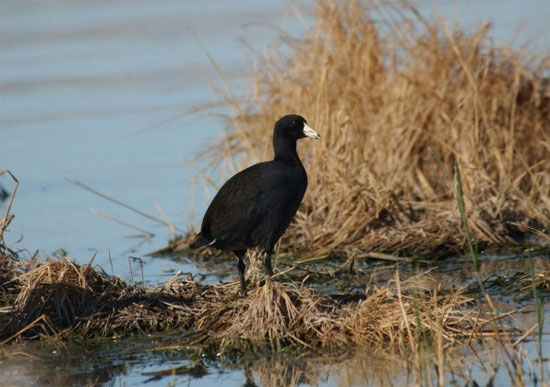When waste water becomes a source of life
Originally a dry delta, La Ciénega de Santa (Mexico) has now "changed its flesh" into a wetland with a rich flora and fauna. The lush green color has long since returned to covering the land with a sewage treatment plant that has been given the title 'miraculous regeneration' by the people.
Located 26km southeast of the border city of Mexicali, Las Arentas wastewater treatment plant is like the city's other sewage treatment plants. It also has a large underground pipeline system that transports nearly 20 million gallons (more than 75 million liters) of Mexicali's wastewater every day. Wastewater will be through conventional treatment steps such as physical, physiological and chlorine treatment to remove bacteria and other harmful agents.

An American coot is swimming.
According to the original design, this plant will transfer treated wastewater into a ditch for agriculture. The water will follow this ditch to the Hardy River and merge into the Colorado River before flowing into the sea. However, after commencing operations in 2007, this factory not only did not meet the basic standards of waste water purification but also directly discharged untreated wastewater into the Hardy River, causing the situation. Severe environmental pollution. For a while, this highly contaminating, stinking sewage flow raged on a long way, passing 24km from Las Arentas to the north across the border, continuing to run through 97km of the Emperor's valley ( USA) before pouring into the Salton Sea.
The situation became so serious that one year later Mexicali's Public Service Commission was involved. Two environmental groups: Pronatura Noreeste of Mexico and the US Sonoran Institute work together to solve the problem of pollution, while preserving the habitat in the delta. The solution that these two groups co-ordinate with the Commission is to build a 100-hectare wetland. Like natural wetlands, this new wetland eliminates pollutants, cleaning up the treated water again before allowing it to flow into the river or to the hands of farmers. people serving agricultural production.
Not only stopping the ability to filter and purify waste water, this wetland also creates habitat for many native birds and migrates, revitalizing the living environment which is narrowed to almost disappear, the consequences of dam construction and change the flow of the Colorado River.

Las Arenitas wastewater treatment plant
In addition, treated waste water nearly doubled the flow of the Hardy River, thereby creating favorable conditions for the development of fisheries economy. Mexican people are not the only ones to benefit from this country. Residents to the north of the border line also witnessed the shedding of the New River, which has been contaminated for years now greener than before.
With the great benefits it brings, the Las Arenitas plant is being planned to double the processing capacity over the next 7 years. Creating more new artificial lakes in the area means increasing the amount of valuable water supplied to the Hardy River.
Javier Orduno Valdez, director of the National Public Service Commission in Mexicali, said the Las Arenitas factory has created a premise for a future of tourism, entertainment and economic development in the region. He is hatching a plan to build a natural park with roads running around the lake as well as holding exhibitions to explain the importance of wetlands to the Hardy River and the delta .
"With this kind of water, we create life for the whole region, " Javier said . What we are doing now is not for us, but for future generations. That's the most important thing'.
- 6 facts that make you change the way you think about using water
- Clean water and numbers to speak
- Small questions: What is the amount of
- Electric waste like global time bomb
- Create hydrogen fuel from sunlight and waste water
- New technology to treat industrial wastewater into clean water
- The incredible source of water on Earth
- Discover equipment that helps families turn domestic waste into energy
- Garbage is also a resource to take advantage of
- Generators from waste water
- Terrifying images of the situation of depleting clean water all over the world
- Found 2 billion years old water
 Is the magnetic North Pole shift dangerous to humanity?
Is the magnetic North Pole shift dangerous to humanity? Washington legalizes the recycling of human bodies into fertilizer
Washington legalizes the recycling of human bodies into fertilizer Lightning stone - the mysterious guest
Lightning stone - the mysterious guest Stunned by the mysterious sunset, strange appearance
Stunned by the mysterious sunset, strange appearance